Thursday, December 9, 2010
uniquely powerful motor
what's on your mind about this bike, like a great bike to crush up to a big tree, so his bike was not damaged body
Labels:
classik,
uniquely powerful motor
Tuesday, December 7, 2010
motorcycle, motorbikes | modification | 2011 Aprilia Dorsoduro 1200 Review
I’m sliding out of every roundabout and each corner. The roads are slippery, but it’s mostly due to the fact that the pace isn’t high enough yet for the hard Pirelli tires. Later when the pace is higher I gain the confidence needed on deadly exciting narrow mountain roads. I continue to insist on riding the maxi-motards supermoto style. I have a lot more fun riding them that way and it’s just as fast a riding style as the conventional knee-down style, if not faster.
The Dorsoduro 1200 is liquid-cooled just like its little brother the 750. Due to this there’s a wide radiator messing with the supermoto riding style a little as your boots can’t reach as far forward to the front wheel as on a proper motard.
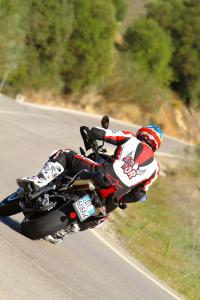
The new steel-trellis frame might look the same as on the 750, but it’s stronger and stiffer and hence a little heavier. Aprilia has compensated a little by making the rear subframe lighter, but there’s no reason to think that improvement won’t benefit the 750 in the future. The Dorsoduro 1200 tackles the corners with great agility and that supermoto feeling where you can place the front wheel exactly where you want.
The Dorsoduro 1200 is a fairly heavy machine (457 pounds claimed dry weight) compared to something like the Ducati Hypermotard but with 30 extra horsepower to compensate. The chassis is ultra stable for this type of bike. Nailing the throttle out of first and second gear corners there’s nothing but smoothness with the correct traction control and riding mode selected.
"The Dorso 1200 just feels nimble and willing to all inputs."
Riding a supermotard to the limit sliding in and out of corners requires some superhuman skills on something like the SXV. The Dorsoduro 1200, however, allows the street-riding public to approach some of those skills in a safe way. With that big 1197cc engine and stiff chassis, I couldn’t feel anything resembling that of riding a heavy bike. The Dorso 1200 just feels nimble and willing to all inputs.
The suspension from Sachs features a 43mm USD fork with a full 160mm travel. The cantilever-style Sachs shock at the back allows 155mm of travel. The long travel allows you to brake deep into corners, and should there not be enough grip, a slide is controllable. At the rear it’s the same story, and the suspension is ready for pretty much any abuse you can think of. Riding in a straight line or even cruising the suspension isn’t too hard and soaks up bumps nearly as well as a full-on supermoto.
The steering angle, despite the big radiator at the front, is free and quick allowing you to make U-turns quicker than a city scooter. One of the great things about off-road and supermoto bikes is the freedom of that front wheel to be placed exactly where you want it to be. The rest of the body simply has to follow in the fashion you decide be it sideways or not. The Dorsoduro takes you toward that freedom while motorcycles like the Shiver don’t.
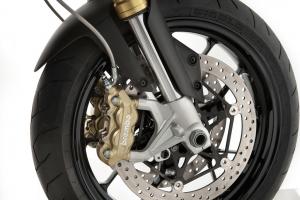
The double 320mm disc setup with radial Brembo brakes ensures plenty of power for braking maneuvers, and the 240mm rear disc with a one-piston Brembo caliper takes care of the sliding into corners nicely. In most markets the Dorsoduro 1200 will be delivered with ABS as standard. I can cope with ABS on the Shiver, but not on the Dorsoduro. The ABS works just fine as a safety feature on a rainy day, but for any other weather condition I’d prefer it off, and luckily Aprilia allows that. The ABS always turns on automatically after turning the ignition completely off and then on.
The 1197cc liquid-cooled 90-degree-vee engine has got that full and rich V-Twin feel that’s missing on the 750. The midrange is rich with torque and Twin goodness, and it accelerates in a rewarding fashion all the way from 4000 rpm and up to the max power of 130 hp at 8700 rpm. In high gears with low load there’s a fine push from 5000 revs. Maximum torque of 84.8 ft-lb at 7200 rpm ensures plenty of momentum even at much lower rpm, exemplifying of a nice and flat curve.
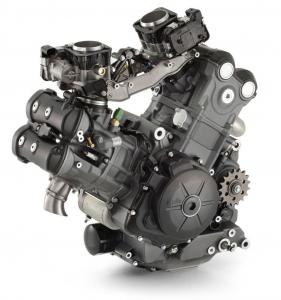
Aprilia has got two sides to it: the full on racing heart represented by the SXV/RXV and RSV4, and the bona fide road bikes represented by the Dorsoduro and Shiver. The difference is that the racing engines are 100% Aprilia-engineered while the 750/1200 engines are Piaggio (which of course also includes Aprilia) -engineered. This is good news if you’re worried about high mileage reliability on as few dealer service appointments as possible.
The new 1200c 130-hp engine isn’t stressed at all, and there’s good reason to expect a touring machine featuring this engine in the near future. The Dorsoduro 1200 accelerates up and above 125 mph easy as anything. On the motorways there’s naturally lots of wind resistance due to the upright riding position, but the seat is long (and a lot comfier than a real supermoto), and I could slide backwards and tuck my off-road helmet nearly low enough to take advantage of the small racing number-plate-style wind cowling. The mirrors provided a decent enough rearward view without too much vibration. There’s no weaving from side to side at high speed such as is typical on a 650cc single-cylinder bike.
Back on the twisty mountain roads is where the Dorsoduro 1200 really shines. In most markets the traction control will be delivered as standard with the ABS. The TC system is basically the same as on the ultra superbike RSV4 Factory APRC but with lots of features and functionality removed. The lower-spec traction control is also all you need on a bike like the Dorsoduro, and it’s adjustable on three levels plus off. I found that it gave me a lot of extra confidence just riding fast with the traction control on setting one which is the least intrusive setting. Move up to two and three and more and more torque is removed from the lower rpm calculations based on pre-programmed maps. Level three along with ABS and the Rain riding mode should allow you to pin the throttle on snow and ice, but it wouldn’t be fun.
The whole point of all these rider aids is that you can, if you wish, tame the beast completely. The best part is perhaps that if you as a less experienced rider want to measure and control your own progression into the high-performance world of motorcycling, you can do this on one bike. Experienced riders like me will have to put up with the annoyance that you can’t change everything while riding. Only the three riding levels of Sport, Touring and Rain can be adjusted while riding, and it’s not in rapid fashion as the throttle must be off and there’s the odd three seconds or more wait which is too much while on the move unless you’re alone on the road.
If you like to pull some wheelies, which by the way is a major selling point of the 130-hp Dorsoduro 1200, then the traction control needs turning off because there’s some calculations needed from the front wheel that simply disappear when the wheel is in the air. That makes the system think it should cut power, which it does. A short wheelie is still possible, but not the long second-gear ones that you really want.
Conclusion
The Dorsoduro 1200 is all I ever wanted from the 750 that wasn’t there. The 1200 engine has got all that full richness I always look for in V-Twins. That sorted, the bike is now 100% pure fun. The Dorsoduro 1200 is better in every area than the 750, and the traction control prevents serious palpitations exiting the corners with big throttle openings on high lean. Despite the large capacity it feels much smaller than BMW’s HP2 for instance. Compared to a proper supermoto, it’s big and heavy, but surely you knew this already so it’s not a point of complaint. Due to the fact that it’s liquid-cooled and reliable, sturdily built and with useful safety features, I’m inclined to say that the Dorsoduro 1200 might be one of the city commuter’s best choices in 2011.
The Dorso 1200 will arrive in North America in the spring of 2011 at a price yet to be announced.
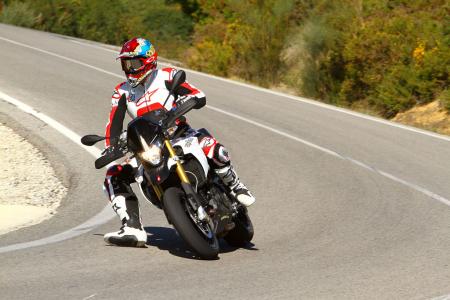 |

The new steel-trellis frame might look the same as on the 750, but it’s stronger and stiffer and hence a little heavier. Aprilia has compensated a little by making the rear subframe lighter, but there’s no reason to think that improvement won’t benefit the 750 in the future. The Dorsoduro 1200 tackles the corners with great agility and that supermoto feeling where you can place the front wheel exactly where you want.
The Dorsoduro 1200 is a fairly heavy machine (457 pounds claimed dry weight) compared to something like the Ducati Hypermotard but with 30 extra horsepower to compensate. The chassis is ultra stable for this type of bike. Nailing the throttle out of first and second gear corners there’s nothing but smoothness with the correct traction control and riding mode selected.
"The Dorso 1200 just feels nimble and willing to all inputs."
Riding a supermotard to the limit sliding in and out of corners requires some superhuman skills on something like the SXV. The Dorsoduro 1200, however, allows the street-riding public to approach some of those skills in a safe way. With that big 1197cc engine and stiff chassis, I couldn’t feel anything resembling that of riding a heavy bike. The Dorso 1200 just feels nimble and willing to all inputs.
The suspension from Sachs features a 43mm USD fork with a full 160mm travel. The cantilever-style Sachs shock at the back allows 155mm of travel. The long travel allows you to brake deep into corners, and should there not be enough grip, a slide is controllable. At the rear it’s the same story, and the suspension is ready for pretty much any abuse you can think of. Riding in a straight line or even cruising the suspension isn’t too hard and soaks up bumps nearly as well as a full-on supermoto.
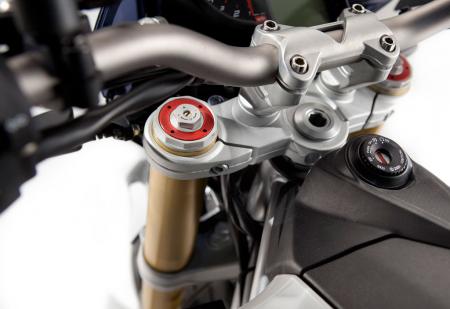 |

The double 320mm disc setup with radial Brembo brakes ensures plenty of power for braking maneuvers, and the 240mm rear disc with a one-piston Brembo caliper takes care of the sliding into corners nicely. In most markets the Dorsoduro 1200 will be delivered with ABS as standard. I can cope with ABS on the Shiver, but not on the Dorsoduro. The ABS works just fine as a safety feature on a rainy day, but for any other weather condition I’d prefer it off, and luckily Aprilia allows that. The ABS always turns on automatically after turning the ignition completely off and then on.
The 1197cc liquid-cooled 90-degree-vee engine has got that full and rich V-Twin feel that’s missing on the 750. The midrange is rich with torque and Twin goodness, and it accelerates in a rewarding fashion all the way from 4000 rpm and up to the max power of 130 hp at 8700 rpm. In high gears with low load there’s a fine push from 5000 revs. Maximum torque of 84.8 ft-lb at 7200 rpm ensures plenty of momentum even at much lower rpm, exemplifying of a nice and flat curve.

Aprilia has got two sides to it: the full on racing heart represented by the SXV/RXV and RSV4, and the bona fide road bikes represented by the Dorsoduro and Shiver. The difference is that the racing engines are 100% Aprilia-engineered while the 750/1200 engines are Piaggio (which of course also includes Aprilia) -engineered. This is good news if you’re worried about high mileage reliability on as few dealer service appointments as possible.
The new 1200c 130-hp engine isn’t stressed at all, and there’s good reason to expect a touring machine featuring this engine in the near future. The Dorsoduro 1200 accelerates up and above 125 mph easy as anything. On the motorways there’s naturally lots of wind resistance due to the upright riding position, but the seat is long (and a lot comfier than a real supermoto), and I could slide backwards and tuck my off-road helmet nearly low enough to take advantage of the small racing number-plate-style wind cowling. The mirrors provided a decent enough rearward view without too much vibration. There’s no weaving from side to side at high speed such as is typical on a 650cc single-cylinder bike.
Back on the twisty mountain roads is where the Dorsoduro 1200 really shines. In most markets the traction control will be delivered as standard with the ABS. The TC system is basically the same as on the ultra superbike RSV4 Factory APRC but with lots of features and functionality removed. The lower-spec traction control is also all you need on a bike like the Dorsoduro, and it’s adjustable on three levels plus off. I found that it gave me a lot of extra confidence just riding fast with the traction control on setting one which is the least intrusive setting. Move up to two and three and more and more torque is removed from the lower rpm calculations based on pre-programmed maps. Level three along with ABS and the Rain riding mode should allow you to pin the throttle on snow and ice, but it wouldn’t be fun.
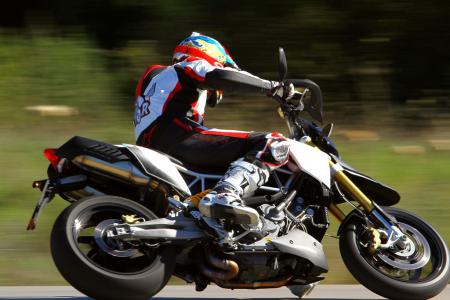 |
If you like to pull some wheelies, which by the way is a major selling point of the 130-hp Dorsoduro 1200, then the traction control needs turning off because there’s some calculations needed from the front wheel that simply disappear when the wheel is in the air. That makes the system think it should cut power, which it does. A short wheelie is still possible, but not the long second-gear ones that you really want.
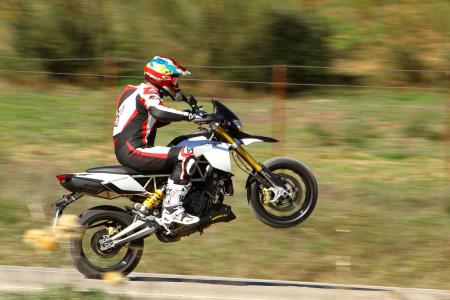 |
The Dorsoduro 1200 is all I ever wanted from the 750 that wasn’t there. The 1200 engine has got all that full richness I always look for in V-Twins. That sorted, the bike is now 100% pure fun. The Dorsoduro 1200 is better in every area than the 750, and the traction control prevents serious palpitations exiting the corners with big throttle openings on high lean. Despite the large capacity it feels much smaller than BMW’s HP2 for instance. Compared to a proper supermoto, it’s big and heavy, but surely you knew this already so it’s not a point of complaint. Due to the fact that it’s liquid-cooled and reliable, sturdily built and with useful safety features, I’m inclined to say that the Dorsoduro 1200 might be one of the city commuter’s best choices in 2011.
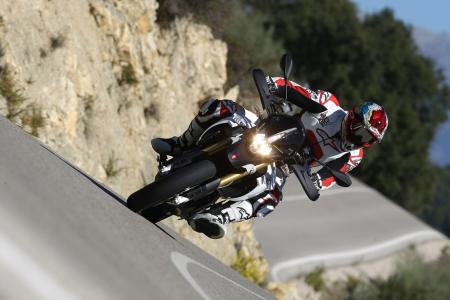 |
| Highs: | Lows: | |
|
|
Labels:
Aprilia
Sunday, December 5, 2010
Retro Honda Scoopy
Let's look at the work of Depok Fadis Nofal. On the front shield is attached a kind of plastic material or swarovski crystal with gold and silver color. Interestingly, at night, it gets swarovski reflection of light from the LED on the top of the headlamp shell.
Views become more classics with the additional sepatbor ornament on the front, side and rear, including orders and a gold emblem on the front and rear wheels.
Another claim results from JJ Airbrush Jaedun Mukhtar, Jakarta. Although minimalist, with a spray gun motif make the appearance Scoopy sweeter. The impression that was strengthened again with ornaments sweetener, from front to back.
Let's look at the standard muffler protector, this section switch motif with translucent model. Seat was redesigned to be shorter and sweeter in the presence of added iron basket.
Another uniqueness, both wheels bolt replaced with a model of the fingers so that further reinforce the retro look. Then, under the tip of the front seat there are variations in the lattice wind. Very sweet!
Different again arable modifier Lipurnomo Johnny, owner of Custom World (CW). He tried to experiment with playing in the foot-feet and the installation of device variations so that, when membesutnya, plus happy
Rear wheels using a wheel Rotara size of 5 x 14 inches. To teromolnya, according to Johnny, the same part BEAT or Vario. Width 5 inches is the maximum size without rewind wheel axis. In addition, there are also unique and caliper cover headlights and a hood wearing sein.
Labels:
Honda,
Honda Scoopy,
Retro Honda
Saturday, December 4, 2010
motor sports |new motorcycle |modification |2011 Harley-Davidson Sportster XR1200X Review
Ask and ye shall receive.
The squeaky wheel gets the grease.
Good things come to those who wait.
Patience is a virtue…
Those cliché adages sum up perfectly the American motorcycle market’s experience with a specific Harley-Davidson model: the XR1200.
When Harley announced in late ’07 the XR1200 as a 2008 European-only model, the decision seemed confounding to Americans who couldn’t buy the Americana-infused XR.
First and foremost because it is, after all, a Harley-Davidson; secondly because its styling is directly inspired by the iconic XR750, Harley’s famous, purpose-built flat-track dominator.
It seemed crazy the States wouldn’t see this “all-American” machine. However, sensible marketing logic was behind excluding the XR1200 from the U.S. market.
As we’ve noted in numerous reviews, the European sport-standard segment is remarkably stronger than is the same segment in the U.S. For reasons not very well understood, we just don’t seem to have an appetite for the nakeds and standards.
Despite this reality of poor sales for sport-standards in the U.S., Harley said it heard enough requests for the XR from its home market, and so by the end of 2008 the Milwaukee-based company introduced the XR1200 for America as a 2009 model.
As something of a cautious homage to the original XR750, the XR1200 saw an initial limited run of only 750 units. Hurray for us anyway!
However, only one year later we were back in that “Europe first” loop.
For 2010 the European market received the XR1200X: an XR with uprated suspension and some additional touchups. American XR owners could have the same suspension package, but only as an optional kit on the order of $1500. Dang.
Welcome home! Round two
Finally, we, too, will now have the XR1200X. It’s the first release of Harley’s 2011 models and it’s slated to hit dealers by this August.
The X model trades the XR1200’s 43mm non-adjustable inverted fork for Showa’s fully adjustable 43mm Big Piston Fork, first seen in wide release on the ’09 ZX-6R. Also swapped out are the fairly basic twin coil-over shocks in favor of fully adjustable 36mm Showa shocks.
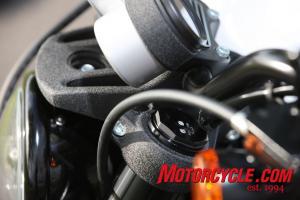 The front half of the XR’s suspension consists of Showa’s Big Piston Fork.
The front half of the XR’s suspension consists of Showa’s Big Piston Fork.
The new Showa shocks retain ramp-style preload adjustment, but the simple compression damping adjustment dial atop the piggyback reservoir(s) is handy.
Also easy to access is the rebound damping adjustment screw found at the bottom of the shock. One caveat: the exhaust impedes access to the right-side shock’s rebound adjuster, so it’s not as easily reached as the left side.
Although the XR-X still employs the same powerful dual, four-piston Nissin calipers from the previous XR model, the 292mm rotors are now of the floating variety.
The spirited 1200cc Sportster engine in the X model gets the black-out treatment, as does the dual upswept exhaust system that’s reminiscent of the XR750’s high pipes. The XR1200’s engine and exhaust were finished in a silvery color.
Orange pinstripes for the three-spoke cast aluminum wheels round out the cosmetic updates.
But perhaps best of all is the X’s MSRP of $11,799, a $1000 increase over the XR1200 model. Recall that the same suspension that’s now on the X model was last year offered as a $1500 upgrade for the standard XR.
Also worth noting, the XR1200X model will replace the XR1200 in 2011.
An American track for an American bike
Harley-Davidson chose a street-only setting for the December 2008 press launch of the XR1200; but for the X’s launch it was wheels up on a famous American racetrack!
Road America, located in the lush countryside of Elkhart Lake, Wis., – about an hour north of Harley’s Milwaukee home – was the venue where American motopress would sample the X. This track was also the first stop in a five-race schedule for the AMA Vance & Hines XR1200 Series.
We ran an abbreviated version of the 14-turn, 4-mile-long circuit, as there was little point in subjecting the XR and its 7K-rpm redline to Road America’s long front straight.
As it was, while in top gear (5th) with the throttle twisted to the stop, the rev limiter routinely cut in to limit my top speed to around 122 mph on the shorter straight between turns 11 and 12. The thing to take away from my rev-limiter-bouncing is that although the XR’s gearing is a wee bit short for track use, this means it has close to ideal gearing for street riding.
While on the subject of redline, the XR-X wasn’t too keen on high-rpm clutch-less upshifts.
The gearbox often resisted such shifting shenanigans, and generally it felt sticky. But on this issue I’m giving it a pass, as the big flywheel in the Twin means lots of engine momentum, which in turn can contribute to lunky shifting. But this isn’t news for a Harley.
Also, most of the bikes we rode displayed low three-digit figures on the odometer. Additional miles might see the trans loosen up.
Best shifting practice was to shift as infrequently as possible. Instead I let the Sportster’s copious low-end torque and large flywheel action dig me out of slower turns.
In 2008 I was impressed by the strong initial bite from the Harley-branded Nissin brakes.
The powerful binders are more than sufficient for street duty, but hauling down the X’s claimed running-order weight of 573 pounds (as well as extra weight from the rider!) from racetrack speeds proved taxing for the brakes.
The closing laps of a 20-min session usually meant some brake fade, and a four-finger grab on the lever in order get the XR-X slowed enough at the end of the aforementioned back straight.
If you plan to take your X model to the track (or XR for that matter), a simple swap to race-compound pads should serve well to improve feel and power. If you’ll only ever ride the streets and canyons, then the XR-X has all the brake you could desire.
Something else Road America revealed about the XR was the bike’s limited lean angles. Of course, this wasn’t a big surprise, as even assertive street riding will result in the long-ish footpeg feelers scraping.
Nevertheless, feeling and hearing the lower exhaust heat shield touch down during the long right-hander (Turn 10), known as the Carousel, was a disquieting experience.
In the time between the first XR’s appearance over two years ago and now, surely Harley would’ve heard enough bellyaching from riders and reviewers about limited ground clearance. It’s a wonder then why The Motor Company didn’t capitalize on the opportunity to increase clearance on the X model, especially in light of its improved performance parameters thanks to the new suspension.
Despite good grip and feedback from the Dunlop Qualifier D209 tires, I wasn’t in a hurry to lever them off the ground by way of grinding the exhaust header into the track surface. These lean-angle annoyances aside, we must remember the XR-X is a streetbike, not a race-prepped supersport.
With that in mind, I must give due credit to how easily the X bike set into turns considering its ready-to-ride weight mentioned above along with its un-sportbike-like 60.0-inch wheelbase. Transitioning from left to right required deliberate action, but leverage offered from the XR’s wide handlebar helped reduce steering input effort.
On the subject of the new suspension, I was content with its performance.
Damping qualities and spring rates seemed perfectly suited for my weight (geared up, roughly 170 lbs) and abilities. Stability was sufficient, as was front-end feedback. However, I can say – again considering weight and skill level – the XR1200 was also up to the task of track duty.
I seized the opportunity to ride an XR1200 back-to-back with the new X model. Although the new BPF front-end and improved shocks provided a moderately firmer feel, the standard suspension on the XR12 wasn’t far off pace in terms of stability and damping quality.
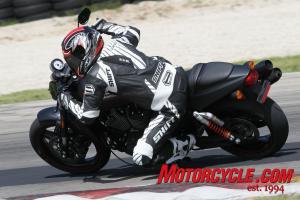 Despite the reality that the XR1200X isn’t ideally suited for racetrack duties, caning a street bike powered by a big Harley Sportster engine around Road America provided endless entertainment.
Despite the reality that the XR1200X isn’t ideally suited for racetrack duties, caning a street bike powered by a big Harley Sportster engine around Road America provided endless entertainment.
Although the previous model’s suspension performed well enough for me on the track, it’s likely a heavier or much more aggressive rider would give a different report and thereby see big benefits from the X model’s adjustable springy parts.
I also took the opportunity to do a 75-mile or so street ride aboard the 2011 XR1200X.
Suspension action was forgiving without sacrificing feel, and it generally provided a decent ride over even the crummiest sections of pavement. All this performance without ever having tweaked suspension settings speaks highly of the upgrades on the new XR1200X.
Small price to pay
The new XR1200X brings the ability to fine-tune suspension adjustments, and as such most riders will find they can resolve most individual handling issues they might encounter on this sportiest of the Sportsters. For this reason alone I cannot conjure a good reason to lament the X’s added cost.
With this latest update to the modern XR series, we can once more thank our motorcycle-loving European brethren (sisters, too, I suppose).
Though it seemed a little odd we were runner-up for an American motorcycle with such an iconic American appearance, I guess, as the saying goes, it was worth the wait, even the second time.
The squeaky wheel gets the grease.
Good things come to those who wait.
Patience is a virtue…
Those cliché adages sum up perfectly the American motorcycle market’s experience with a specific Harley-Davidson model: the XR1200.
When Harley announced in late ’07 the XR1200 as a 2008 European-only model, the decision seemed confounding to Americans who couldn’t buy the Americana-infused XR.
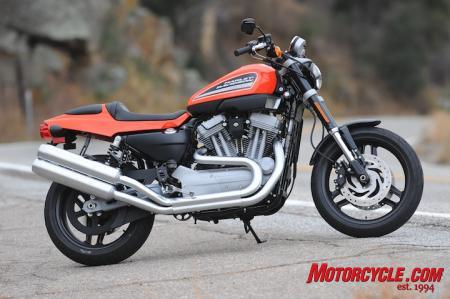 Here’s the XR1200 that we didn’t get first. Here’s the XR1200 that we didn’t get first. |
It seemed crazy the States wouldn’t see this “all-American” machine. However, sensible marketing logic was behind excluding the XR1200 from the U.S. market.
As we’ve noted in numerous reviews, the European sport-standard segment is remarkably stronger than is the same segment in the U.S. For reasons not very well understood, we just don’t seem to have an appetite for the nakeds and standards.
Despite this reality of poor sales for sport-standards in the U.S., Harley said it heard enough requests for the XR from its home market, and so by the end of 2008 the Milwaukee-based company introduced the XR1200 for America as a 2009 model.
However, only one year later we were back in that “Europe first” loop.
For 2010 the European market received the XR1200X: an XR with uprated suspension and some additional touchups. American XR owners could have the same suspension package, but only as an optional kit on the order of $1500. Dang.
Welcome home! Round two
Finally, we, too, will now have the XR1200X. It’s the first release of Harley’s 2011 models and it’s slated to hit dealers by this August.
The X model trades the XR1200’s 43mm non-adjustable inverted fork for Showa’s fully adjustable 43mm Big Piston Fork, first seen in wide release on the ’09 ZX-6R. Also swapped out are the fairly basic twin coil-over shocks in favor of fully adjustable 36mm Showa shocks.
Also easy to access is the rebound damping adjustment screw found at the bottom of the shock. One caveat: the exhaust impedes access to the right-side shock’s rebound adjuster, so it’s not as easily reached as the left side.
Although the XR-X still employs the same powerful dual, four-piston Nissin calipers from the previous XR model, the 292mm rotors are now of the floating variety.
The spirited 1200cc Sportster engine in the X model gets the black-out treatment, as does the dual upswept exhaust system that’s reminiscent of the XR750’s high pipes. The XR1200’s engine and exhaust were finished in a silvery color.
Orange pinstripes for the three-spoke cast aluminum wheels round out the cosmetic updates.
But perhaps best of all is the X’s MSRP of $11,799, a $1000 increase over the XR1200 model. Recall that the same suspension that’s now on the X model was last year offered as a $1500 upgrade for the standard XR.
An American track for an American bike
Harley-Davidson chose a street-only setting for the December 2008 press launch of the XR1200; but for the X’s launch it was wheels up on a famous American racetrack!
We ran an abbreviated version of the 14-turn, 4-mile-long circuit, as there was little point in subjecting the XR and its 7K-rpm redline to Road America’s long front straight.
As it was, while in top gear (5th) with the throttle twisted to the stop, the rev limiter routinely cut in to limit my top speed to around 122 mph on the shorter straight between turns 11 and 12. The thing to take away from my rev-limiter-bouncing is that although the XR’s gearing is a wee bit short for track use, this means it has close to ideal gearing for street riding.
While on the subject of redline, the XR-X wasn’t too keen on high-rpm clutch-less upshifts.
The gearbox often resisted such shifting shenanigans, and generally it felt sticky. But on this issue I’m giving it a pass, as the big flywheel in the Twin means lots of engine momentum, which in turn can contribute to lunky shifting. But this isn’t news for a Harley.
Also, most of the bikes we rode displayed low three-digit figures on the odometer. Additional miles might see the trans loosen up.
Best shifting practice was to shift as infrequently as possible. Instead I let the Sportster’s copious low-end torque and large flywheel action dig me out of slower turns.
In 2008 I was impressed by the strong initial bite from the Harley-branded Nissin brakes.
The powerful binders are more than sufficient for street duty, but hauling down the X’s claimed running-order weight of 573 pounds (as well as extra weight from the rider!) from racetrack speeds proved taxing for the brakes.
The closing laps of a 20-min session usually meant some brake fade, and a four-finger grab on the lever in order get the XR-X slowed enough at the end of the aforementioned back straight.
If you plan to take your X model to the track (or XR for that matter), a simple swap to race-compound pads should serve well to improve feel and power. If you’ll only ever ride the streets and canyons, then the XR-X has all the brake you could desire.
Something else Road America revealed about the XR was the bike’s limited lean angles. Of course, this wasn’t a big surprise, as even assertive street riding will result in the long-ish footpeg feelers scraping.
Nevertheless, feeling and hearing the lower exhaust heat shield touch down during the long right-hander (Turn 10), known as the Carousel, was a disquieting experience.
Despite good grip and feedback from the Dunlop Qualifier D209 tires, I wasn’t in a hurry to lever them off the ground by way of grinding the exhaust header into the track surface. These lean-angle annoyances aside, we must remember the XR-X is a streetbike, not a race-prepped supersport.
With that in mind, I must give due credit to how easily the X bike set into turns considering its ready-to-ride weight mentioned above along with its un-sportbike-like 60.0-inch wheelbase. Transitioning from left to right required deliberate action, but leverage offered from the XR’s wide handlebar helped reduce steering input effort.
Damping qualities and spring rates seemed perfectly suited for my weight (geared up, roughly 170 lbs) and abilities. Stability was sufficient, as was front-end feedback. However, I can say – again considering weight and skill level – the XR1200 was also up to the task of track duty.
I seized the opportunity to ride an XR1200 back-to-back with the new X model. Although the new BPF front-end and improved shocks provided a moderately firmer feel, the standard suspension on the XR12 wasn’t far off pace in terms of stability and damping quality.
Although the previous model’s suspension performed well enough for me on the track, it’s likely a heavier or much more aggressive rider would give a different report and thereby see big benefits from the X model’s adjustable springy parts.
I also took the opportunity to do a 75-mile or so street ride aboard the 2011 XR1200X.
Suspension action was forgiving without sacrificing feel, and it generally provided a decent ride over even the crummiest sections of pavement. All this performance without ever having tweaked suspension settings speaks highly of the upgrades on the new XR1200X.
Small price to pay
The new XR1200X brings the ability to fine-tune suspension adjustments, and as such most riders will find they can resolve most individual handling issues they might encounter on this sportiest of the Sportsters. For this reason alone I cannot conjure a good reason to lament the X’s added cost.
With this latest update to the modern XR series, we can once more thank our motorcycle-loving European brethren (sisters, too, I suppose).
Labels:
Harley-Davidson
motor sports |new motorcycle |modification |EICMA 2010: Ducati Diavel and Monster EVO Unveiling
MV Agusta motorcycles will soon be available in Canada after the Italian manufacturer appointed a new importer.
Aftermarket parts and accessories company Motovan has been named the exclusive Canadian importer of MV Agusta.
“We have finally succeeded in obtaining all of the necessary approvals from the Canadian authorities therefore the motorcycles can be imported into Canada for the very first time in the history of MV Agusta,” says Umberto Uccelli sales director MV Agusta. “After many inquiries from Canadian consumers, we are very proud to have reached an agreement with a reputable Canadian powersports organization such as Motovan.”
James Paladino, president and chief executive officer of Motovan Corporation, says his family has roots in Italy with MV Agusta.
“We are very happy to be associated with MV Agusta so that our passion lives on in our family,” says Paladino. “To me, this is a tribute to my father (founder of Motovan) since he worked on MV Agusta motorcycles in the 1950’s from his shop in a little village in Italy”
Aftermarket parts and accessories company Motovan has been named the exclusive Canadian importer of MV Agusta.
“We have finally succeeded in obtaining all of the necessary approvals from the Canadian authorities therefore the motorcycles can be imported into Canada for the very first time in the history of MV Agusta,” says Umberto Uccelli sales director MV Agusta. “After many inquiries from Canadian consumers, we are very proud to have reached an agreement with a reputable Canadian powersports organization such as Motovan.”
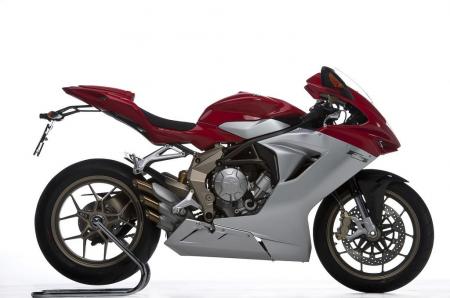 MV Agusta motorcycles like the upcoming F3 will soon be available in Canada. MV Agusta motorcycles like the upcoming F3 will soon be available in Canada. |
“We are very happy to be associated with MV Agusta so that our passion lives on in our family,” says Paladino. “To me, this is a tribute to my father (founder of Motovan) since he worked on MV Agusta motorcycles in the 1950’s from his shop in a little village in Italy”
Labels:
Ducati
Subscribe to:
Posts (Atom)




